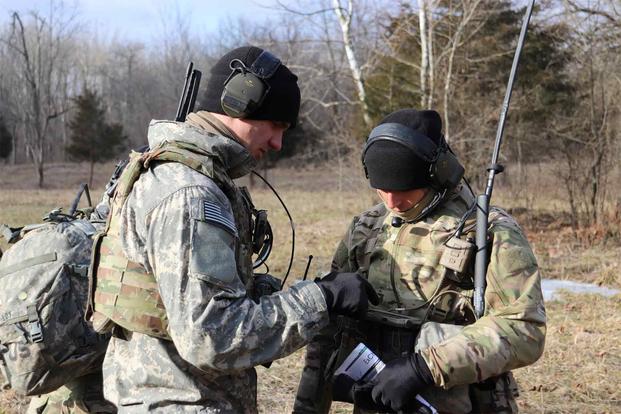U.S. Army modernization officials are pushing forward with a plan to outfit light infantry, Stryker and armored combat brigades with advanced radios and communications kits designed to speed decision-making even under sophisticated enemy jamming attacks.
"We want to give them radios and systems that allow the data to flow in a contested environment," Maj. Gen. Peter Gallagher, director of the Army Network Cross-Functional Team, told defense reporters Tuesday at a tactical network demonstration at Joint Base Myer-Henderson Hall in Arlington, Virginia.
Developing and fielding a more robust tactical network that can stand against enemy cyber and electronic warfare, or EW, attacks is one of the Army's top modernization priorities.
The service is currently designing, testing and fielding two-year capability sets -- Capability Set 21 for light infantry brigade combat teams, or BCTs; Capability Set 23 for Stryker BCTs; and Capability Set 25 for armored BCTs.
Read Next: British Aircraft Carrier Departs on Landmark Deployment with Marine Corps F-35s Aboard
Earlier this year, the Army began fielding Capability Set 21 -- which includes new man-packable and handheld radios, commercial satellite terminals, commercial network gateway devices and command-and-control software -- to four infantry BCTs, with plans for more in the future.
The 1st BCT, 82nd Airborne Division, at Fort Bragg, North Carolina, and the 173rd Airborne Brigade in Europe have received the new sets. The Army will field them to the 3rd BCT, 25th Infantry Division, in Hawaii next month and 3rd BCT, 82nd Airborne, later this year.
"CS 21 is predominantly infantry, light infantry dismounts," said Brig. Gen. Robert Collins, Program Executive Officer for Command, Control, Communications-Tactical, or PEO C3T. "In Cap Set 23, we are putting it on Stryker vehicles. You are actually going to see mobile communications, mobile [command and control] on the move on Stryker platforms."
The Army just completed the preliminary design review for Cap Set 23. Over the next year, the service will experiment with the Cap Set 23 to prove out new technologies and identify risk areas before going into the critical design review scheduled for April 2022, Collins said.
Cap Set 23, and eventually Cap Set 25, will be designed to build on top of Cap Set 21 with new capabilities such as incorporating access to low-Earth orbit and mid-Earth orbit commercial satellite constellations.
"Low-Earth orbit satellites offer dramatically increased [data] throughput and reduced latency, which is a huge game-changer on the battlefield," Collins said.
Cap Set 23 and beyond will also provide significant defense against enemy jamming attacks, he said.
"You have to be able to [operate] a contested, congested environment ... whether it's EW jamming, cyber threat," Collins explained.
The Army offers cooperative research and development agreements to small companies that can't afford to stand up an environment that can replicate a cyber attack from Russia or China.
"If I am a small company, I can come in with my new technology and expose it to a jammer or to a threat or to a hacker," Collins said.
Army officials stressed that the new capability set approach will allow them to break from the stationary communications structure on forward operating bases that the service relied on for almost two decades in Iraq and Afghanistan.
"We've gotta get out of buildings and tents and be able to be mobile and distributed in a very, very violent fight," Gallagher said.
-- Matthew Cox can be reached at matthew.cox@military.com.
Related: Marine Corps Searching for New Battlefield Communication System












